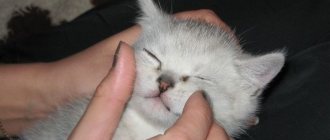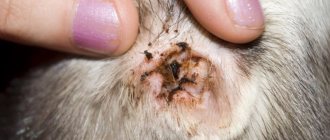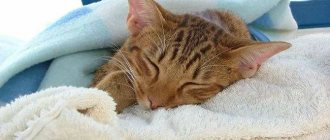In normal condition, cats' ears are a healthy pink color. If you notice brown dirt during your examination, this may indicate an ear infection. What to do if you find dirty ears on your cat?
In the article we told you how to clean your ears and the consequences of lack of hygiene. We figured out in what cases discharge in the ears should not cause concern, and described the causes of infections and inflammation. You will learn what signs indicate the onset of the disease, and what treatment methods exist.
The process of cleaning a cat's ears
Cats are great at keeping their bodies clean, but sometimes they need help reaching hard-to-reach places like their ears. Most pets are not very fond of such interventions, but this is necessary to ensure not only cleanliness, but also health.
In addition to earwax contamination, you can often find an unusual dark-colored coating in your cat's ears. This may indicate pathologies, and in this case it is best to immediately contact a specialist.
Therefore, it is important to understand the possible causes of dirt in cats’ ears.
This is what a healthy cat ear looks like
Causes of dirty ears
Cat ears produce earwax, which cleans and lubricates the ear canals and protects the hearing from dirt and insects. Dust sticks to the earwax, so pets who sometimes walk outside may get their ears more dirty and dirty more often. Those with large ears are also susceptible to heavy contamination. Sulfur is released gradually and even a large accumulation of it does not give the ears a painful appearance: the auricles retain a healthy pink color.
The ears of some pets produce more wax, in which case it is necessary to help the animal maintain hygiene more often. Increased production of ear secretions does not indicate abnormalities or pathologies. However, if sulfur is not removed in a timely manner, inflammatory processes may develop. Also, in exceptional cases, increased sulfur production can be caused by a malfunction of the hormonal system or hypothermia. To exclude such precedents, it is better to show the owner of such ears to a doctor.
In addition, the following reasons explain why dirt accumulates in a cat’s ears.
Elves are susceptible to pollution due to their lack of hair and ear shape
Lack of wool
Hairless cats do not have additional ear protection. In addition, some of them have large ears or, like elves, curved ear tips. In addition to the fact that pollution accumulates faster and more, the body produces sulfur more intensely to ensure protection of the hearing organs from infections. These cats need more careful and frequent ear care.
Allergic reaction
Allergies can be caused by food or change of food, dust, fur of other animals, chemicals, fleas. The manifestation of the reaction on the skin is characterized by increased ear secretion, peeling and change in skin color, and itching. The cat begins to worry and scratch, sometimes trying to penetrate deep into the ear canal; in other cases, animals scratch the skin around the ears until abrasions form, which can cause additional infections.
Atopic dermatitis is a genetic disease and cannot be completely cured. Signs include dry skin and itching, rashes and the formation of ulcers, including in the ears.
Otitis
Inflammation of the middle or inner ear, which may be caused by external trauma, infection in the ear canals, as well as complications due to ear mites or stress. Young animals, individuals with weakened immune systems and a lack of vitamins in the diet are more susceptible to otitis than others. Signs of the disease include inflammation of the skin in the ear canals, hearing loss, severe itching and pain, causing the cat to constantly scratch.
Otitis media must be treated immediately, otherwise the pet may go deaf.
Ear mites under a microscope
Otodectosis
According to statistics, almost three quarters of hearing diseases are caused by otodectosis, otherwise known as ear mites. Microorganisms penetrate the ear canal, feed on blood and skin, multiply and leave waste products, which are oily brown or brown lumps. A cat can become infected with ear mites from other animals and from bacteria brought from the street by a person on their hands or clothing. With otodectosis, the cat's ears are dirty and very itchy, the animal shakes its head, and the discharge has an unpleasant odor.
How often to clean your ears
Whether a cat’s ears need to be cleaned can only be determined after a careful examination. It is advisable to do it daily. You should make it a rule that when your pet sits comfortably on your lap, look into its ears. If there are no dark deposits, stains, dots or scratches, no cleaning is required. Clean ears that do not bother the cat can be cleaned once every few months as a preventive measure.
Your cat's ears need to be cleaned if:
- dirt, dusty deposits;
- spots, dots or bumps that are black or brown;
- dry dark crusts;
- excess sulfur, purulent discharge;
- scratches, dried blood;
- unpleasant odor from the ear canal.
It is also necessary to cleanse if the cat shakes its head and constantly scratches its head behind the ears.
Ears should be examined daily and cleaned as soon as they become dirty.
Diagnostic methods
It is not difficult to treat any diseases of the hearing organs, but only at the initial level of the disease.
Therefore, if you suspect a pathology, it is important to visit a veterinarian as soon as possible.
The reason for seeking qualified medical help should be any changes in the animal’s habitual behavior and well-being.
The following signs indicate a possible infection with ear mites or ongoing inflammatory processes:
- scratched skin in and/or around the ear;
- restless behavior accompanied by frequent head shaking and ear scratching;
- thick, lumpy brown plaque in the ears;
- unpleasant odor emanating from plaque;
- feeling of increased humidity in the ear;
- frequency of contamination: often the day after cleaning the situation even worsens;
- unhealthy skin appearance: redness, scabs, sores, rashes;
- the cat often tilts its head to the side;
- lethargy and refusal to eat or, on the contrary, anxious behavior;
- formation of pus and/or appearance of blood;
- swelling of the tissues of the ear canals or ears;
- the cat does not respond to sounds and does not respond to its name;
- lack of coordination;
- discharge of fluids from their ears;
- The cat won't let you touch its ears because it hurts.
View of the ear of an animal infected with otodectosis
What does dirt in a cat's ears mean?
The body of any living creature has its own characteristics. The appearance of dirt in the ear canals of a completely healthy cat is usually not a cause for concern. But sometimes this sign means that the animal has a dangerous disease or that the inflammatory process of the hearing organ is intensively developing. Under normal conditions, the inside of a cat's ears are light pinkish in color. They may contain a little sulfur secretion and ordinary dust. In this case, an unpleasant odor will never emanate. Often, mites are hidden under the dirt in the ear canals, which poses a danger to your pet's health.
This is especially worth paying attention to if the cat constantly shakes its head and scratches its ears. In such a case, you cannot do without the help of a veterinarian, since only a specialist is able to establish the true cause of the animal’s illness and choose the best option to combat the problem. You should not self-medicate your animal. But, if you carry out regular preventive examination of your pet’s ears and carry out hygienic cleaning according to the rules, such a problem is unlikely to arise.
Brown discharge from a cat's eyes: causes and treatment
How to treat
You can begin to fight the disease only after a visit to a veterinarian, who will prescribe treatment depending on the cause of the pathogen. Cleaning the ears in case of illness without proper treatment can cause serious health consequences.
- Otodectosis
To treat otodectosis, antiparasitic drugs are usually prescribed in the form of injections, drops on the animal’s withers and ear drops. Before instillation of the ears, it is necessary to clean the ears well, otherwise the drug will not reach the source of infection, and the therapeutic effect will be low. Drops in the withers are an excellent way to combat ear mites, especially if the animal does not tolerate cleaning and putting drops in the ears.
In advanced cases of otodectosis, injections are prescribed; the course is on average ten days, during which the procedure must be carried out three times. This method of treatment brings stress and pain to the pet, but some cases of the disease can only be treated in this way. That is why it is important to prevent its development in the early stages of the disease.
If there is more than one animal living in the house, then all of them are treated for otodectosis at once to prevent re-infection and to eliminate the source of the disease.
Constant ear scratching is one of the signs of illness.
- Otitis
Therapy is prescribed depending on the symptoms and usually consists of complex treatment. For infectious otitis, antibiotics are prescribed, antifungal drugs are prescribed for inflammation caused by fungus.
If ear inflammation becomes chronic, surgical intervention is necessary.
Against the background of chronic otitis, the development of neoplasms and hyperplasia of the auditory canal is possible. In this case, timely surgical intervention is necessary.
Due to the wide range of causes and forms of development of the disease, it will not be possible to cure a cat on your own; this will only lead to complications during the course of the disease.
- Allergic reaction
To establish the cause of the allergy and make sure that it was the cause of poor health, it is necessary to take tests for a number of indicators. The doctor will determine what exactly causes rejection in the body.
If the food is not selected in accordance with the needs of the animal’s body, it will certainly cause allergies, which usually manifests itself in the form of itching and skin rashes.
Allergy result
When an allergy is diagnosed, it is recommended to replace food or eliminate foods that cause the reaction, and prescribe certain diets. And to improve well-being, antihistamines and anti-inflammatory drugs are prescribed.
It is worth distinguishing between allergies and intolerances to certain ingredients. For example, vomiting and diarrhea after eating dairy products indicate lactose intolerance. If it occurs frequently, your pet may develop complications such as bacterial and infectious diseases.
How to properly clean a cat's ear
Ears should be checked regularly; each animal has its own rate of ear secretion, so it will have to be removed at different intervals. If your cat has dirty ears, you need to do some preparation and find out how to clean them more effectively. To speed up the process and minimize the animal’s stress, it is better to prepare everything you need in advance: cotton pads, ear cleaning gel. And if your pet offers physical resistance, you will need a towel to immobilize the “patient.” It is good if one of your relatives helps you hold the cat during the procedure.
Do not use alcohol-containing products to clean your ears; they can dry out the skin of the ear canals.
Ear cleaning scheme
- The cleaning product is dripped into the ear (1-2 drops) and left for a couple of minutes, allowing the cat to shake its head and shake out the excess amount of the product;
- Gently bend the ear, as if turning it outward;
- Holding your head, wipe the inside of your ears with a cotton pad. You can use cotton swabs, but it is important to clean in an outward motion, otherwise you may create a wax plug. The stick should not go more than one centimeter into the ear.
Ear cleaning scheme
The procedure for cleaning ears is not the most pleasant for a cat, so it should be done when the animal is calm. Praise your pet throughout the process because it may be difficult for him. At the end of the event, be sure to pet and give a treat to develop a positive association, so that in the future the pet will get used to maintaining hygiene of its hearing organs.
Rules for cleaning ears
To carry out hygiene measures you do not have to run after your pet throughout the house, pull it out from under the bed or remove it from the closet, before the procedure you should play with it a little or caress it. Everything you need must be prepared in advance. In order to calm a cat, it is enough to stroke it and talk in a calm, quiet voice. Prepare your favorite treat. A small piece can be given in advance.
How to properly clean your ears:
- wrap your pet in a thin blanket;
- Gently bend the ear outward so that all the curves of the inner part become visible. It doesn't hurt cats;
- soak a cotton pad or soft cloth in the cleanser and lightly wipe the entire inside of the ear;
- if there is a lot of dirt, then you should take a clean disk and repeat the cleansing;
- The cotton swab should also be moistened and all bends should be thoroughly cleaned. If necessary, the procedure should be repeated.
It is a myth that a pet's eardrum can burst. In cats, there is a bend in the ear, and it is impossible to reach the eardrum with a stick. The only thing that can cause harm is scratching the thin skin if the stick is very hard or if you clean it carelessly.
It is important to carry out all cleaning movements from the inside out, otherwise you can push dirt inside the ear canal, which can cause an inflammatory disease.
When to contact a veterinarian
It is recommended to visit the veterinarian regularly, performing a preventive examination every six months. This will help to identify diseases in the early stages of development, when it is possible to cure the animal more easily and quickly, without exposing the body to serious danger, surgery or exposure to potent medications.
Here are a number of reasons for an urgent unscheduled visit to the veterinary clinic:
- uncharacteristic odor from the ears;
- a large amount of discharge that appears very quickly;
- refusal of active games;
- decreased appetite;
- general depression;
- lack of shine in the coat, which becomes ragged;
- the appearance of blood and pus;
- constant attempts to scratch in and around the ear.
If you notice dirt in the ears, it is best to take your cat to the doctor.
Prevention of ear diseases in animals
To prevent ear pollution, you need to use a special lotion
To prevent your pet from suffering from ear diseases, follow simple rules of prevention: constantly clean his hearing organ.
Buy a special lotion, drops and cotton swabs for this and remove dirt and wax from your ears once a week.
Every cat owner knows that simple, unnoticeable dirt in the ear can be the first symptom of a serious illness. If you do not delay treatment, it will not be difficult. It’s better to just do preventive maintenance and regularly clean your cat’s ears.











